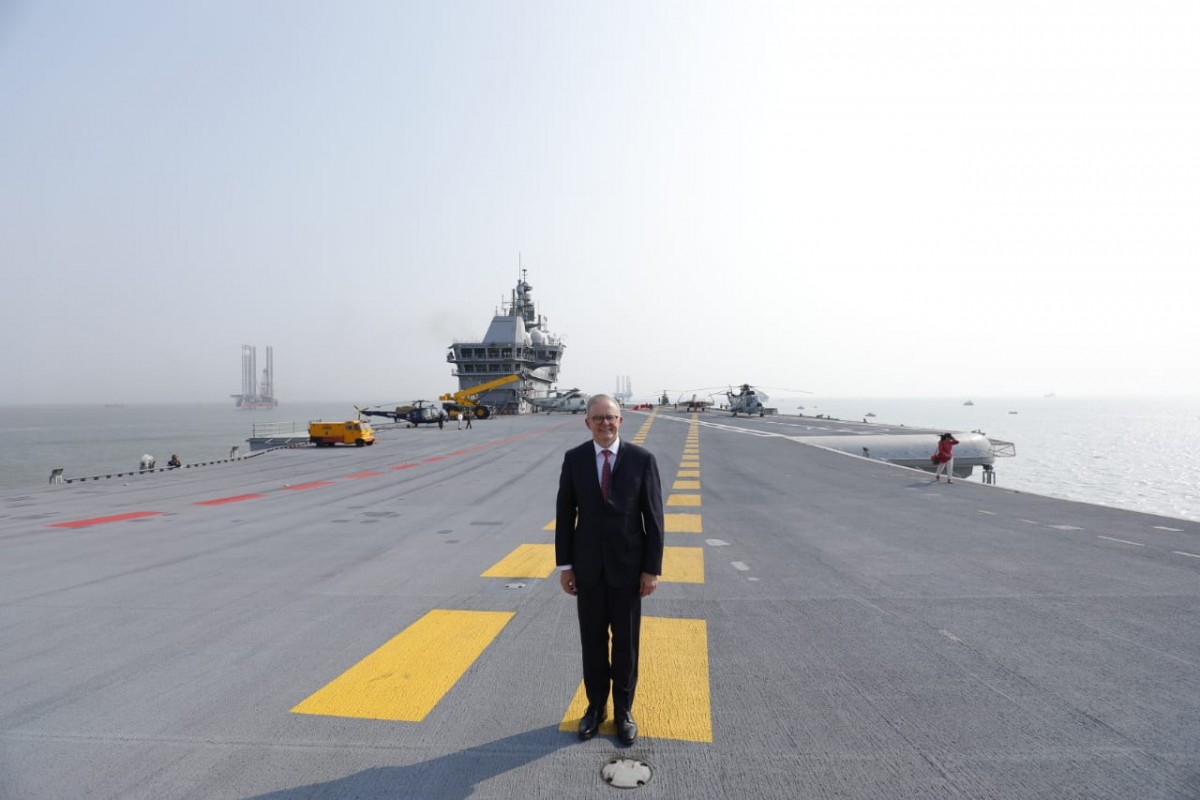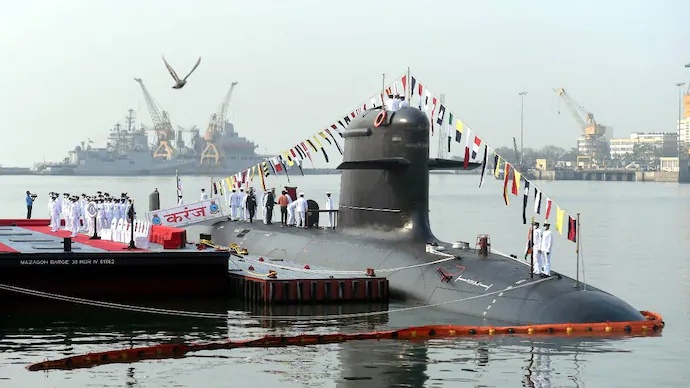Navy Must Clear Many Hurdles If It Wants Second Indigenous Aircraft Carrier
Chandigarh: The Indian Navy (IN) has noticeably stepped up its lobbying for a second indigenous aircraft carrier-2 (IAC-2) by flamboyantly flaunting INS Vikrant, its maiden IAC-1, in recent weeks as its talisman for power projection.
After its commissioning in September 2022, following a six-year delay and a six-fold cost overrun, the 40,262-tonne short take-off barrier arrested recovery (STOBAR) Vikrant, built by Cochin Shipyard Limited (CSL), again grabbed headlines in February, after a Russian MiG-29K fighter and a prototype Light Combat Aircraft (Navy) landed consecutively on its deck. The two landings comprised Vikrant’s ongoing Air Certification and Flight Integration Trials that are scheduled to end later this year, following which the carrier would be operationally deployable.
Thereafter, in quick succession, Vikrant hosted the bi-annual naval commanders' conference in early March and soon after received Australian Prime Minister Anthony Albanese on board in a blaze of raucous publicity. And, days earlier, in a related event aimed at keeping the momentum for IAC-2 in motion, the IN hosted the sixth, five-day long meeting of the US-India Joint Working Group on Aircraft Carrier Technology Cooperation that concluded on March 3.

Prime Minister of Australia Anthony Albanese on INS Vikrant. Photo: Twitter/@indiannavy
Established in 2015, the Joint Working Group has met at least four times – intermittently in the US and in India – to discuss the IN's proposed carrier plans. But so far, it has remained primarily a ‘talking shop’, till Ministry of Defence (MoD) approvals were secured to definitively progress IAC-2. Putatively this is envisaged as a 65,000-tonne platform – tentatively named INS Vishal – equipped with a Catapult Assisted Take-Off But Arrested Recovery (CATOBAR) system to launch its fighter complement.
And, in between the IN Chief of Staff Admiral R. Hari Kumar declared at Aero-India 2023 in Bengaluru in February that the IN was considering ordering an add-on Vikrant-class platform, but with modifications, while continuing to plan for yet another larger carrier. This ‘interim’ endeavour, the IN chief stated, would sustain CSL’s carrier-building expertise, achieved over decades and prevent it from lapsing till MoD clearances were obtained for the bigger platform capable of deploying advanced fighters, airborne early warning and control (AEW&C) platforms and unmanned combat air vehicles (UCAVs). These plans were in consonance with the navy’s long-standing determination in becoming a three-carrier force – one for each seaboard and one in reserve – to augment its burgeoning operational ambitions.
Admiral Kumar had argued in Bengaluru that by the time a third carrier, albeit of the same tonnage as Vikrant was commissioned, INS Vikramaditya (ex-Admiral Gorshkov), the 46,000-tonne refurbished Kiev-class Aviation Cruiser commissioned in late 2013, would be nearing retirement. “Then we would need to build another carrier,” he added. CSL, meanwhile, claimed its ability to construct another Vikrant-sized carrier within eight years, or in half the time it took to build the recently commissioned vessel.
Previously, in May 2015 the MoD had sanctioned Rs 30 crore to the Directorate of Naval Design (DND) in New Delhi to begin conceptualising plans for IAC-2, but little or nothing had progressed thereafter. Despite such obstacles, however, the IN has continued to doggedly pursue the IAC-2 option, but faces severe headwinds from multiple quarters, some even within the service itself.
Also Read: Why India Needs a Large Aircraft Carrier: An Ex-Submariner Makes the Case
Operational efficacy of IAC-2
The unresolved debate over IAC-2 has been plagued not only by its astronomical cost but also its overall operational efficacy in an environment of burgeoning anti-access/area denial (A2/AD) capability honed by India’s two nuclear rivals China and Pakistan, against carrier attacks, The A2/AD is essentially a multi-layered defensive strategy that employs long-range ballistic and cruise missiles, attack drones and cyber weapons deployed on coastal areas, warships, submarines and fast attack craft to deter enemy carrier operations.
Collectively these offensive/defensive assets were aimed at creating a ‘secure bubble’, which carriers, their combat air arm and accompanying escort platforms would be wary of challenging because of the potential lethality they could encounter. Furthermore, recent advances in cruise missile technology had made it easier and cheaper for countries like China and Pakistan to conduct A2/AD operations. So much so that even the US Navy considered China’s evolved A2/AD strategy a serious threat to its fleet of some 11 advanced 100,000-tonne nuclear-powered carriers.
Besides, even within the IN, senior officers questioned the monetary logic of building a new carrier at the cost of inducting additional diesel-electric ‘killer-hunter’ submarines (SSKs) – whose numbers had depleted to 16, of which 11 from Russia and Germany were between 19 and 33 years old, and nearing retirement. These SSKs were eight boats fewer than the 24 submarines that the Navy was projected to operate by 2030 in accordance with its Maritime Capability Perspective Plan. Correspondingly, equally critical surface combatants like corvettes, nine-sweepers, destroyers and frigates too were in short supply, as were naval utility helicopters and unmanned aerial vehicles and other assorted missiles and ordnance.
These officers’ reasoning centred on the unresolved debate in other navies around the world between operationally pursuing a ‘sea denial’ strategy, largely by deploying submarines, or alternately seeking a ‘sea control’ approach via costly and relatively more vulnerable carrier battle groups (CBGs) that entail an inordinately large number of surface and underwater escorts.
In the recently concluded round of the four-month-long TROPEX 23 exercises, Vikrant’s CBG comprised 17 platforms including frigates, destroyers and corvettes. This, however, was in consonance with the IN's Doctrine that incorporates CBGs on the grounds that these comprise the most ‘substantial’ instruments in securing this latter aim of sea control, as these assets possess ‘ordnance delivery capability of a high order’; these assist the Navy in prevailing over the enemy’s ‘Centre of Gravity’ by degrading the Decisive Points.

Indian Navy officers on board during the commissioning ceremony of P-75 INS Karanj submarine into the Indian Navy, in Mumbai, on March 10, 2021. Photo: Shashank Parade/PTI
IAF competition for defence budget
The other principal opponent to financing a carrier for the IN remains the Indian Air Force (IAF), which too is forever competing for a greater share of depreciating annual defence budgets, as it grapples to make good its fighter, helicopter and transport aircraft shortages, amongst other essential equipment.
“We need to prioritise our military equipment procurements in keeping with regional threats and limited financial resources that are fast reducing,” said military analyst Air Marshal V.K. Bhatia (retd). Under these precarious financial conditions, an aircraft carrier would not only be a costly indulgence he added, but also entail fielding a platform vulnerable to A2/AD threats.
Other IAF officers declared that Anglo-French fighters like SEPECAT Jaguar IM/IS and multi-role Russian Sukhoi Su-30MKIs fitted with enhanced maritime strike capability and extended strike ranges, via in-flight re-fuelling, could project power more economically and securely than a carrier. The IAF’s maritime Jaguar IM fleet, for instance, is armed with AGM-84L Block II Harpoon missiles of which India acquired 24 units in 2010 for $170 million and is also being equipped with Israel Aerospace Industries-Elta EL/M-2052/2060 multi-mode active electronically scanned array (AESA) radar for sea-borne operations.
And in early 2020, the IAF commissioned its first Su-30MKI squadron, coast armed with the BrahMos-A(Air) supersonic cruise missile with a 292km strike range, at Thanjaur on India’s southeast coast to monitor the country’s eastern and western seaboards and the wider Indian Ocean Region (IOR). Military planners said that deploying the Su-30MKIs armed with the BrahMos-A to police the IOR was a strategically prudent move in response to China’s expanding naval footprint in the area. They said that the Su-30MKI with its 1,500km operational range – without the assistance of mid-air re-fueling, and much further with it – would enhance the IAF's capability to engage potential targets with pinpoint accuracy.
Declining budget forces tightening of belt
But the steadily declining defence budget remains the principal bulwark to thwart IAC-2. In recent years, the IN has been forced to tighten its belt by revising its goal of operating 200 assorted warships by 2027 in keeping with its Maritime Capability Perspective Plan to just 175. Furthermore, fiscal shortages had, for instance, forced the navy into reducing its long-standing requirement for 12 Mine Counter Measure Vessels to eight and an additional 10 Boeing P-8I Neptune long-range, maritime multi-mission aircraft to just six platforms.
And, to mitigate shortages the IN was upgrading technology and weaponry on existing and under-construction platforms and finding cheaper substitutes. The Maritime Capability Perspective Plan had also envisaged the IN operating 458 fixed and rotary wing platforms by the end of this decade; but in view of the prevailing financial resource crunch, these numbers too had been revised downwards to around 320, naval sources said, adding that even these quantities were ‘aspirational’.
Besides, IAC-2 had been strongly opposed by the former Chief of Defence Staff General Bipin Rawat who argued that the navy needed more submarines than carriers, which themselves required their own individual armadas for protection. Other navalists too had suggested upgrading the military capabilities of the ‘unsinkable’ Andaman and Nicobar archipelago by creating an A2/AD maritime ‘exclusive zone’ around it to deter, amongst others China’s hegemonistic People’s Liberation Army Navy . The views of General Rawat’s successor, General Anil Chauhan, with regard to IAC-2 were, for now, unknown.
“The IN is forcefully pushing its case for an additional carrier,” said military analyst Rear Admiral Raja Menon (retired). But he suggested – despite the momentum for greater indigenisation and fostering CSL’s expertise in carrier building – the IN needed to ‘outsource’ IAC-2 to the UK, which was capable of delivering a carrier in five years for an estimated $3.2 billion, or in less than half the time it would take to domestically build it.
In conclusion, it remained to be seen whether demonstrably parading Vikrant will pay dividends for the IN in obtaining government sanction for it, or will it remain merely a showpiece mascot.
This article went live on March eighteenth, two thousand twenty three, at thirty-five minutes past two in the afternoon.The Wire is now on WhatsApp. Follow our channel for sharp analysis and opinions on the latest developments.




